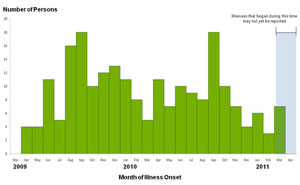Investigation Update: Outbreak of Human Salmonella Typhimurium Infections Associated with Contact with Water Frogs
April 7, 2011
On this Page
Today's Highlights
- As of April 5, 2011, a total of 217 individuals infected with the outbreak strain of Salmonella Typhimurium have been reported from 41 states since April 1, 2009. These infections are associated with contact with water frogs, specifically, African dwarf frogs.
- A single water frog breeder in California has been identified as the source of African dwarf frogs associated with human infections. This breeding facility was first identified as the source of African dwarf frogs associated with human infections in 2010. Past information about this investigation in 2009-2010 can be found on the CDC Salmonella page.
- In late March 2011, local health department staff visited the frog breeder and collected environmental samples. These samples were tested in CDC laboratories and were found to be positive for Salmonella bacteria; additional testing is ongoing to determine if this Salmonella strain is the outbreak strain.
Introduction
CDC is collaborating with public health officials in many states to investigate a multistate outbreak of human Salmonella Typhimurium infections associated with contact with water frogs, such as African dwarf frogs. Water frogs commonly live in habitats such as aquariums or fish tanks. As of April 5, 2011, a total of 217 individuals infected with the outbreak strain of Salmonella Typhimurium have been reported from 41 states since April 1, 2009. The number of ill person identified in each state is as follows: Alaska (5), Alabama (2), Arizona (10), California (17), Colorado (12), Connecticut (3), Florida (1), Georgia (4), Idaho (4), Illinois (8), Indiana (1), Kansas (2), Kentucky (4), Louisiana (2), Massachusetts (6), Maryland (5), Michigan (6), Minnesota (1), Missouri (5), Mississippi (1), Montana (2), North Carolina (1), Nebraska (2), New Hampshire (3), New Jersey (3), New Mexico (2), Nevada (3), New York (7), Ohio (7), Oklahoma (1), Oregon (5), Pennsylvania (14), South Dakota (3), Tennessee (4), Texas (4), Utah (18), Virginia (11), Vermont (1), Washington (23), Wisconsin (3), and West Virginia (1).
Among the persons for whom information is available, illnesses began April 9, 2009. Infected individuals range in age from less than 1 year old to 73 years old. Seventy-one percent of patients are younger than 10 years old, and the median age is 5 years old. Fifty-one percent of patients are female. Among ill persons, 34% were hospitalized. No deaths have been reported.
Surveillance for additional illness continues through analysis of data in PulseNet, the national network of public health and food regulatory agency laboratories coordinated by the Centers for Disease Control and Prevention (CDC).
Investigation of the Outbreak
CDC, in collaboration with many state and local health departments, is continuing to investigate an outbreak of Salmonella infections associated with contact with water frogs, specifically, African dwarf frogs. In interviews, ill persons answered questions about contact with animals and foods consumed during the days before becoming ill. Sixty-four percent of ill persons reported contact with frogs in the week before their illness began. Of ill persons who could recall the type of frog they had contact with, 84% identified African dwarf frogs. The median time from acquiring a frog and illness onset was 15 days, with a range of 7 to 240 days. Findings of traceback investigations identified a single water frog breeder in California as the source of African dwarf frogs associated with human infections. This frog breeding facility was first identified as the source of African dwarf frogs associated with human infections in 2010. Information about this investigation in 2009-2010 can be found on the CDC Salmonella page.
Environmental testing also links the infection to a single African dwarf frog breeding facility in California. Because of the evidence of an ongoing problem, local health department officials visited the frog breeder in late March 2011 and collected environmental samples. These samples were tested in CDC laboratories and were found to be positive for Salmonella bacteria; additional testing is ongoing to determine if this Salmonella strain is the outbreak strain.
Clinical Features/Signs and Symptoms
Most persons infected with Salmonella bacteria develop diarrhea, fever, and abdominal cramps 12 to 72 hours after infection. The illness usually lasts 4 to 7 days, and most persons recover without treatment. However, in some persons, the diarrhea may be so severe that the patient needs to be hospitalized. Salmonella infection may spread from the intestines to the bloodstream, and then to other body sites and can cause death unless the person is treated promptly with antibiotics. The elderly, infants, and those with impaired immune systems are more likely to have a severe illness from Salmonella infection. More general information about Salmonella can be found here.
General Advice About How to Care for Water Frogs

- Wash hands thoroughly with soap and water right after handling anything, including water, that comes in contact with water frogs or from inside their habitat (e.g., aquarium or fish tank). Since the water from inside their habitat can carry the same germs as the water frogs themselves, following proper handwashing practices is very important. Adults should assist young children with hand washing.
- Kitchen sinks should not be used to empty or wash the frog’s habitat (e.g., aquarium or fish tank). If possible, empty and wash the habitat outside of the home, using disposable gloves. If bathtubs are used for cleaning the frog’s habitat, they should be cleaned thoroughly and disinfected with bleach. Young children should not be allowed to clean the frog’s habitat (e.g., aquarium or fish tank).
- Be aware that Salmonella infections can be caused not only by water frogs, but by other amphibians and reptiles, such as turtles. More information about how to enjoy pets safely can be found on the CDC Healthy Pets Healthy People Website.
Advice to Parents and Caregivers
- People at highest risk for serious Salmonella infections are children under 5 years old, older persons, pregnant women, or people who have weak immune systems, such as cancer patients and those undergoing chemotherapy or organ transplants. These people should avoid contact with water frogs and anything that comes in contact with these frogs, their water, and their habitat (e.g., aquarium or fish tank).
- Water frogs are not an appropriate pet for children under 5 years old, and if possible, should not be present in homes with children of this young age. Also, keep water frogs out of childcare centers, hospitals, and nursing homes.
- Keep any habitat (e.g., aquarium or fish tank) with water frogs out a child’s bedroom, especially children under 5 years old. Handle all surfaces that have come in contact with water frogs as if they are contaminated with Salmonella bacteria, because there is a good possibility that they are.
- If you have a water frog, watch for symptoms of Salmonella infection, such as diarrhea, fever, and abdominal cramps. Call your health care provider if you or a family member has any of these symptoms.
Advice to Pet Stores/Others Who Sell or Display Water Frogs
- Pet stores and others who sell or display water frogs should provide health-related information to owners and potential purchasers of water frogs near the water frog display prior to the point of purchase, not at the cash register. This should include information about the risk of acquiring a Salmonella infection from water frogs and their habitat (e.g., fish tank or aquarium) and instructions for proper cleaning of the frog’s habitat.
- More information on displaying animals in public settings can be found in the 2009 Compendium of Measures to Prevent Diseases Associated with Animals in Public Settings.
Advice to Health Care Providers
- Ask parents or caregivers about pet and animal ownership, especially amphibians (e.g., frogs) and reptiles (e.g, turtles), and provide education about the risk of acquiring a Salmonella infection from contact with the animals, their habitat (e.g., fish tank or aquarium), or water. Advise parents and caregivers on proper handwashing practices.
Advice to Veterinarians
- Provide education to clients with water frogs about the risk of acquiring a Salmonella infection from contact with water frogs and their habitat (e.g., fish tank or aquarium).
- Provide education to clients with water frogs on how to properly clean the water frogs’ habitat (e.g., fish tank or aquarium).
Previous Updates
Get email updates
To receive email updates about this page, enter your email address:
Contact Us:
- Centers for Disease Control and Prevention
1600 Clifton Rd
Atlanta, GA 30333 - 800-CDC-INFO
(800-232-4636)
TTY: (888) 232-6348 - New Hours of Operation
8am-8pm ET/Monday-Friday
Closed Holidays - cdcinfo@cdc.gov




